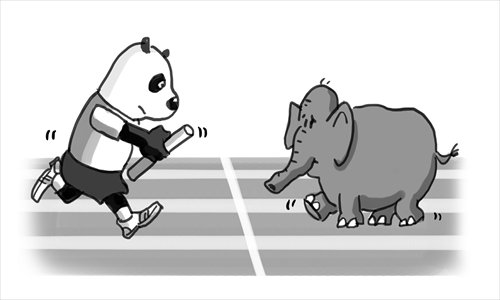HOME >> OP-ED
China’s sunset industries ripe for India
By Ding Gang Source:Global Times Published: 2014-11-27 0:43:01

Illustration: Liu Rui/GT
One of the major measures taken by the Indian government under newly elected Prime Minister Narendra Modi is comprehensively developing the manufacturing industry so that "Make in India," a favorite Modi slogan will occupy an important position in the global production chain as "Made in China" does now.
Promoting India's manufacturing industry is key to the sustainable development of its economy and also indispensable for this developing country to edge itself into the developed world.
India has a lot of disadvantages in developing its manufacturing industry. For instance, its market has yet to be open enough to foreign capital; it has too many small enterprises and a poorly educated workforce. The country is also confronted with age-old problems in infrastructure including insufficient power supply and shabby roads.
Nevertheless, the country also boasts several advantages. As Modi once stated, a large population, especially a massive young population who know English well, and a cheap labor force can contribute to the "Make in India" campaign.
Despite all these, India's backward manufacturing industry is not a fresh topic, and the strengths and weaknesses stated above have been present for a long time.
In actuality, India has been longing to beef up its manufacturing industry for over a decade, but failed to achieve substantial results. It has been more empty talk than actual deeds.
The Indian government has failed to find the key areas that need to be supported by industrial policies, and Indians themselves could hardly make their own advantages clear to potential investors.
Now with the ambitious slogan and the concrete plan, the Modi administration will be more motivated than before and win more staunch support from the public. What it needs to do now is to find a key point to make a breakthrough.
New Delhi has to learn from China's experience in this regard. Justin Yifu Lin, a well-known Chinese economist, has put forward a new idea of comparative advantage based on the experience of China's economic development during the past several decades.
According to Lin, any country has strengths in boosting its own economy, but the linchpin lies in whether it can discover its potential advantages and implement guidelines for industries step by step.
There is a shortcut for India to recognize its own potential edge: What manufacturing sectors can it take over from China, or what sectors does China expect to or have to transfer abroad?
The global manufacturing chain has now been fully segmented. What India needs to move into are the products China has been making but lacks advantages in doing so compared with India. In other words, China's sunset industries are where India's hope lies.
Chinese corporations that manufacture these products can bring not only capital and order, but also technologies, managerial expertise, market and support in other arenas.
However, New Delhi's strict control and regulation have set obstacles for Chinese enterprises to enter its market in recent years. For example, some textile firms would rather choose Vietnam, Cambodia and even Myanmar as their investment destinations.
The Modi government has decided to put in place an open policy in 25 sectors including textile, biochemistry, iron and steel, as well as petroleum. But this, however, is far from enough. It needs to adopt more preferential policies toward the Chinese manufacturing industry.
At present, the key to promoting India's manufacturing industry is not whether it can replace China, but whether it can give full play to its own advantages.
India should take over some manufacturing sectors from China, just as the Chinese mainland once did from Japan and the four Asian Tigers, namely, Hong Kong, Singapore, South Korea, and Taiwan.
If India can follow China's steps in a steadfast manner, there is hope that it will surpass the current biggest international manufacturing hub.
And if the two countries can draw up a plan of comprehensive cooperation in manufacturing, it will exert far-reaching influence upon the changes in the Asia-Pacific architecture.
The author is a senior editor with People's Daily. He is now stationed in Brazil. dinggang@globaltimes.com.cn. Follow him on Twitter at @dinggangchina